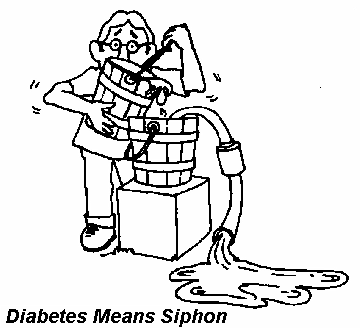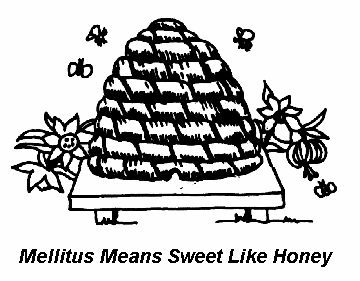

Mellitus comes from a Latin word that means sweet like honey. The urine of a person with diabetes contains extra sugar (glucose). In 1679,the physician Thomas Willis, tasted the urine of a person with diabetes and described as ‘wonderfully sweet’ like honey.

A more thorough and in depth definition of diabetes is any disorder characterized by excessive urine excretion. The most common form is diabetes mellitus, a metabolic disorder in which there is an inability to oxidize carbohydrates due to a disturbance in insulin production or function. Diabetes mellitus is characterized by elevated glucose in the plasma and episodic keto-acidosis.
To learn about the history of diabetes click here: file:///N|/My Documents/DM_REAL.html
How does
hyperglycemia occur?
To learn how hyperglycemia
occurs click here: hyperglycemia.html
Criteria
Needed for Diabetes Mellitus Diagnosis:
1) Having a fasting glucose
level in excess of 140 mg/dL
2) Or having plasma glucose
levels in excess of 200 mg/dL at two time points during a glucose tolerance
test (GTT), one of which must be within 2hrs. of ingestion of glucose.
Glucose Tolerance Curve
This is a glucose tolerance
curve for a normal person and one with insulin-independent diabetes mellitus.
(This graph compliments of: http://www.bmb.leeds.ac.uk/teaching/icu3/practic/bmb3/)
To
learn more about the diagnosis of diabetes click here
Pre-Diabetes
Pre-diabetes
is a condition in which blood glucose levels are higher than normal but
are not high enough for a diagnosis of diabetes. People with pre-diabetes
are at an increased risk for developing type 2 diabetes and for heart disease
and stroke.
Symptoms
of Diabetes Mellitus:
Frequent urination – the
kidney dam
Excessive thirst
Dry Skin
Itchy Skin
Slow healing of cuts
Blurry eyesight
Always feeling hungry
Feeling tired and weak
Weight loss
Skin infections
Numbness of tingling in feet
Why these
symptoms occur:
When blood
glucose rises above a certain level, it is removed from the body in urine.
A resulting increase in the volume of urine occurs due to the osmotic effect
of glucose. Picture the kidney as a dam: when there is too much glucose
in the blood, the excess is diluted with water and spills out. The maximum
blood glucose level reached before sugar spills out is called the kidney
threshold and is usually about 180 mg/ml. This results in two conditions:
polyuria or excessive urination and glycosuria or glucose in the urine.
The loss of water through urination triggers the brain to send a message
of thirst. This results in a condition known as polydipsia or excessive
thirst. Excessive urination can also lead to dehydration, which accounts
for the dry, itchy skin. The blurred vision can be caused by fluctuations
in the amount of glucose and water in the lenses of the eyes. As far as
always feeling hungry this is because there is no insulin or the insulin
is unable to activate the uptake of glucose into the cells and therefore
the cells are starving. This triggers the brain to send a message of hunger,
resulting in polyphagia or excessive hunger. The fact that the cells are
low on energy also explains why there are feelings of fatigue and weakness.
Weight loss may occur in people due to the inability to supply the cells
with the needed amount of glucose. The complication of skin infections
occurs at times because of the excess glucose in the blood, this excess
glucose suppresses natural defense mechanisms such as the activity of white
blood cells and the glucose is also an excellent food source for bacteria.
And finally, numbness and tingling in the feet and night leg cramps may
result from nerve damage due to prolonged high glucose levels that cause
changes in the nerves.
Types Of
Diabetes:
Most people with diabetes
have one of two major types. About 10% have type 1 or insulin dependent
diabetes mellitus (IDDM). About 85% suffer from type 2 or non-insulin dependent
diabetes mellitus (NIDDM).
| Type 1 (IDDM) | Type 2 (NIDDM) | |
| Age of Onset | Usually under 40 years | Usually over 40 years |
| Body Weight | Thin | Usually overweight |
| Symptoms | Appear suddenly | Appear slowly |
| Insulin Produced | None | Too little, or ineffective |
| Insulin Required | Must take insulin | May require insulin |
| Other Names | Juvenile Diabetes | Adult onset diabetes |
Other types
of diabetes:
Impaired glucose tolerance:
A condition in which the blood contains more glucose than normal but less
than is required for a diagnosis of diabetes (aka pre-diabetes)
Gestational diabetes mellitus: A condition that occurs when the level of blood glucose rises in women as a complication of pregnancy. The blood glucose levels usually return to normal after delivery
Secondary diabetes mellitus: A condition with the same symptoms as diabetes mellitus however it is due to disease of the pancreas or endocrine system, genetic disorders, or exposure to chemical agents.
Insulin-Dependent
Diabetes Mellitus (IDDM)
To learn about Insulin-Dependent
Diabetes Mellitus click here: type
1.html
Non-Insulin-Dependent
Diabetes Mellitus
To learn about Non-Insulin-Dependent
Diabetes Mellitus click here: type
2.html
Treating
Diabetes:
IDDM:
It has
been determined that hyperglycemia is responsible for the long-term microvascular
complications of diabetes. Thus, the therapy for IDDM should try to intensify
metabolic control to lower blood glucose levels while avoiding hypoglycemic
episodes. Treatments for IDDM include but are not limited to the following:
1) Diet
2) Education
3) Plasma glucose monitoring
a. Glycosylated hemoglobin
b. Fructosamine levels
c. Urine ketone levels
4) Insulin therapy
5) Oral anti-diabetic drugs
To learn more about insulin therapy in the treatment of IDDM click here:
NIDDM:
The treatment for NIDDM is
very similar to IDDM with slight variations in oral anti-diabetic drugs.
Type 2 diabetes can often be treated with diet and lifestyle changes alone,
without the need for medication.
To learn more about the anti-diabetic drugs used to treat NIDDM click here:
To
learn more about the overall treatment of diabetes mellitus click here:
Interesting
and educating sites relating to diabetes mellitus:
http://www.medscape.com/viewarticle/445672
- The rise of childhood type 1 diabetes in the 20th century
http://www.medscape.com/viewarticle/450150-Economic costs of diabetes in the US in 2002
http://www.niddk.nih.gov/health/diabetes/pubs/type1-2/what.htm-Your
guide to diabetes: Type 1 and
Type 2
http://www.medscape.com/viewarticle/444392-Potential of Surgery for Curing Type 2 Diabetes Mellitus
http://www.medscape.com/viewarticle/444348- Current Approaches to Type 2 Diabetes Mellitus
http://www.medscape.com/viewarticle/449887 - Insulin Therapy in Type 2 Diabetes
http://www.medscape.com/viewarticle/438369 - Perspectives on Islet Transplantation
http://www.medscape.com/viewprogram/1967
- Insulin Replacement/Insulin Technologies